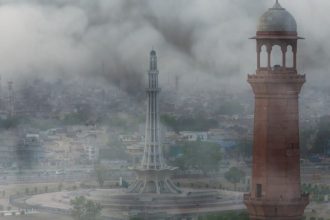The US drone strike that killed Islamic State’s commander for Afghanistan and Pakistan was the latest blow to the Middle East-led movement’s ambitions to expand into a region where the long-established Taliban remain the dominant Islamist force.
Islamic State has enticed hundreds, perhaps thousands, of jihadist fighters in Afghanistan and Pakistan to switch loyalty and has held a small swath of territory in the eastern Afghan province of Nangarhar, where leader Hafiz Saeed Khan was killed on July 26 by a US drone, Washington confirmed late Friday.
But outside that pocket of territory, security officials and analysts say that Islamic State remains – for now – more of a “brand name” than a cohesive militant force in much of the region.
“Groups around the world want to jump on that bandwagon and cash in on their popularity and the fear they command,” said a Pakistani police official based in Islamabad, on condition of anonymity because he was not authorized to speak to media.
Anxiety over Islamic State – also known as ISIS or “Daesh” – in Afghanistan and Pakistan has been building since the al Qaeda breakaway movement seized portions of territory in Iraq and Syria in 2014 and began promoting itself worldwide.
Those fears had gain fresh impetus in the last month after IS’s self-declared “Khorasan province” in Afghanistan and Pakistan claimed two especially deadly bombings that each killed more than 70 people – one in the Afghan capital, Kabul, and the latest in the south-western Pakistani city of Quetta last week.
Yet Pakistani officials and independent analysts have raised doubt on the IS claims, especially for the Quetta bombing – saying the more credible claim for the suicide attack at a hospital was by a Pakistani Taliban offshoot, Jamaat-ur-Ahrar.
“ISIS is increasingly on the defensive as it struggles to defend its shrinking caliphate in Iraq and Syria, so it has a strong incentive to show it’s still relevant by taking credit for something it didn’t do,” said Michael Kugelman, South Asia analyst for the Woodrow Wilson Centre, a US-based think tank.
Shifting loyalties?
Two years ago, Islamic State was the world’s hot new name in the eyes of jihadists bent on using violence to destroy secular institutions and impose their harsh interpretation of Islam.
Jamaat-ur-Ahrar, in fact, at one point swore allegiance to Islamic State’s leader Abu Bakr al-Baghdadi in 2014 during a spat with the Pakistani Taliban leadership.
Several months later, however, JA had switched back to the Taliban banner, and when it claimed responsibility for the Aug. 8 suicide bombing in Quetta it used its full name “Tehreek-e-Taliban Pakistan Jamaat-ur-Ahrar”.
Islamic State has made it clear that it is committed to developing its “Khorasan province”, declared in January 2015.
When the central IS leadership claimed responsibility for the Quetta bombing it issued statements in Arabic, English and Urdu, the latter language native mostly to Pakistan.
“Khorasan” has special significance in Islamic State’s ideology because it refers both to a historic region encompassing much of modern-day Iran, Afghanistan and Pakistan, and also a prophecy of a Muslim army emerging from the same region to conquer all of the Middle East, including Jerusalem.
History and prophecies aside, the attraction of South Asia for Islamic State is obvious enough, due to the many opportunities to recruit existing, well-armed fighters and bomb makers.
With literally dozens of loosely allied Islamist groups operating in Afghanistan and Pakistan, the region is ripe for a ready-made switch of allegiances.
Global jihadist “market”
But the fledgling IS movement in both Pakistan and Afghanistan faces challenges.
Various Taliban factions and their al Qaeda allies – who vehemently oppose al-Baghdadi’s claim to lead a nascent global caliphate – still control vast, overlapping networks of finance from opium, kidnappings and taxes on areas under their sway.
“It would be too big a price to pay for any Pakistani group to join a group that the Afghan Taliban have outright rejected,” said the Pakistani police official.
Aside from their seizure of several districts of Nangarhar from the Taliban, the newly declared Islamic State loyalists have taken no other major territory in Afghanistan.
Both the Taliban and Islamic State have also been pummelled by US drone strikes and Afghan security forces offensives in Nangarhar – including the one that killed Khan.
The United States said last week an estimated 300 IS fighters had been killed in July.
The death of the local leader is not a fatal blow to Islamic State’s still-limited operational capabilities in the region, but it does represent a dent to its “brand” in a region rife with options for waging jihad.
Wilson Center’s Kugelman described the difference between the appeal of the Islamic State name in Afghanistan and Pakistan compared with other parts of the world.
“In Europe, disaffected and disgruntled local Islamists won’t find many enticing options at home. This prompts them to make the trip to the Middle East to join ISIS,” Kugelman said.
By contrast, in Pakistan and Afghanistan “the newly radicalized in search of an affiliation don’t need to gravitate to ISIS because they already have so many other options”. (Reuters)





